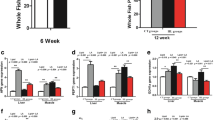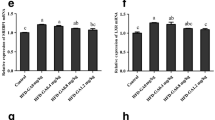Abstract
In the intensive culture systems, excessive feeding leads to ammonia accumulation, which results in lipid metabolism disorder. However, little information is available on the modulation of lipid metabolism in fish as affected by feeding frequency and ammonia stress. In this study, weight gain increased as feeding frequency increased from one to four times daily, but feed conversion ratio is opposite. The highest survival was found in ammonia group when fish was fed two times daily. Liver ammonia content increased as feeding frequency increased from one to four times daily, and the highest brain ammonia content was found when fish was fed four times daily. The highest liver 6-phospho-gluconate dehydrogenase (6PGD), fatty acid synthase (FAS), carnitine palmitoyltransferase (CPT), and lipoprotein lipase (LPL) contents were found in control group when fish was fed four times daily; in comparison, the highest liver 6PGD, FAS, CPT, and LPL contents were found in ammonia group when fish was fed two times daily. Liver 6PGD, FAS, CPT 1, SREBP-1, and PPARα mRNA expression in control group increased significantly as feeding frequency increased from one to four times daily, and the highest expression of 6PGD, G6PD, and FAS was observed in ammonia group when fish was fed two times daily. This study indicated that the optimal feeding frequency is two times daily when yellow catfish exposed to ammonia.

Similar content being viewed by others
References
Abu-Elheiga L, Almarza-Ortega DB, Baldini A, Wakil SJ (1997) Human acetyl-CoA carboxylase 2 . Molecular cloning, characterization, chromosomal mapping, and evidence for two isoforms. J Biol Chem 272(16):10669–10677
Bergmeyer HU, Beutler HO (1985) Ammonia. In: Bergmeyer HU, Bergmeyer J, Grabl M (eds) Methods of enzymatic analysis. Academic Press, New York, pp 454–461
Carvalho CS, Fernandes MN (2008) Effect of copper on liver key enzymes of anaerobic glucose metabolism from freshwater tropical fish (Prochilodus lineatus). Comp Biochem Phys A 151(3):437–442
Chen QL, Gong Y, Luo Z, Zheng JL, Zhu QL (2013) Differential effect of waterborne cadmium exposure on lipid metabolism in liver and muscle of yellow catfish (Pelteobagrus fulvidraco). Aquat Toxicol 142:380–386
Fan XW, Li M, Yuan LX, Lai H, Song MZ, Wang RX, Zheng RQ (2017) Effects of feeding frequency on the enzymes and genes involved in oxidative stress in juvenile yellow catfish Pelteobagrus fulvidraco (Richardson) exposed to ammonia. Aquac Res 48:5874–5882
Felipo V, Butterworth RF (2002) Neurobiology of ammonia. Prog Neurobiol 67(4):259–279
Guo ZX, Cui JY, Li M, Liu HH, Zhang MZ, Meng FX, Shi G, Wang RX, He XY, Zhao YM (2018) Effect of feeding frequency on growth performance, antioxidant status, immune response and resistance to hypoxia stress challenge on juvenile dolly varden char Salvelinus malma. Aquaculture 486:197–201
Hegazi MM, Hasanein SS (2010) Effects of chronic exposure to ammonia concentrations on brain monoamines and ATPases of Nile tilapia (Oreochromis niloticus). Comp Biochem Phys C 151(4):420–425
Hegazi MM, Attia ZI, Ashour OA (2010) Oxidative stress and antioxidant enzymes in liver and white muscle of Nile tilapia juveniles in chronic ammonia exposure. Aquat Toxicol 99(2):118–125
Hermenegildo C, Monfort P, Felipo V (2000) Activation of N-methyl-D-aspartate receptors in rat brain in vivo following acute ammonia intoxication: characterization by in vivo brain microdialysis. Hepatology 31(3):709–715
Hernández C, Martın M, Bodega G, Suárez I, Pérez J, Fernández B (1999) Response of carp central nervous system to hyperammonemic conditions: an immunocytochemical study of glutamine synthetase (GS), glial fibrillary acidic protein (GFAP) and 70 kDa heat-shock protein (HSP70). Aquat Toxicol 45(2):195–207
Ip YK, Leong MW, Sim MY, Goh GS, Wong WP, Chew SF (2005) Chronic and acute ammonia toxicity in mudskippers, Periophthalmodon schlosseri and Boleophthalmus boddaerti: brain ammonia and glutamine contents, and effects of methionine sulfoximine and MK801. J Exp Biol 208(10):1993–2004
Li M, Chen LQ, Qin JG, Li EC, Yu N, Du ZY (2013) Growth performance, antioxidant status and immune response in darkbarbel catfish Pelteobagrus vachelli fed different PUFA/vitamin E dietary levels and exposed to high or low ammonia. Aquaculture 406-407:18–27
Li X, Tian H, Zhang D, Jiang G, Liu W (2014a) Feeding frequency affects stress, innate immunity and disease resistance of juvenile blunt snout bream Megalobrama amblycephala. Fish Shellfish Immun 38:80–87
Li M, Yu N, Qin JG, Li EC, Du ZY, Chen LQ (2014b) Effects of ammonia stress, dietary linseed oil and Edwardsiella ictalurid challenge on juvenile darkbarbel catfish Pelteobagrus vachelli. Fish Shellfish Immun 38:158–165
Li M, Gong S, Li Q, Yuan L, Meng F, Wang R (2016) Ammonia toxicity induces glutamine accumulation, oxidative stress and immunosuppression in juvenile yellow catfish (Pelteobagrus fulvidraco). Comp Biochem Phys C 183:1–6
Li MJ, Liu WS, Luo W, Zhang XQ, Zhu WL, Wang J, Liao LY, Li GH (2017) Polymorphisms and their association with growth traits in the growth hormone gene of yellow catfish, (Pelteobagrus fulvidraco). Aquaculture 469:117–123
Lindley TE, Scheiderer CL, Walsh PJ, Wood CM, Bergman HL, Bergman AL, Laurent P, Wilson P, Anderson PM (1999) Muscle as the primary site of urea cycle enzyme activity in an alkaline lake-adapted tilapia, Oreochromis alcalicus grahami. J Biol Chem 274(42):29858–29861
Liu QN, Xin ZZ, Chai XY, Jiang SH, Li CF, Zhang HB, Ge BM, Zhang DZ, Zhou CL, Tang BP (2016) Characterization of immune-related genes in the yellow catfish (Pelteobagrus fulvidraco) in response to LPS challenge. Fish Shellfish Immun 56:248–254
Luo Z, Tan XY, Zheng JL, Chen QL, Liu CX (2011) Quantitative dietary zinc requirement of juvenile yellow catfish (Pelteobagrus fulvidraco), and effects on hepatic intermediary metabolism and antioxidant responses. Aquaculture 319(1):150–155
Luo Z, Wei CC, Ye HM, Zhao HP, Song YF, Wu K (2016) Effect of dietary choline levels on growth performance, lipid deposition and metabolism in juvenile yellow catfish (Pelteobagrus fulvidraco). Comp Biochem Phys B 202:1–7
MOAC (Ministry of Agriculture China) (2017) China fisheries yearbook. In: Agriculture Publisher. Beijing, China
Morash AJ, Kajimura M, McClelland GB (2008) Intertissue regulation of carnitine palmitoyltransferase I (CPT I): mitochondrial membrane properties and gene expression in rainbow trout (Oncorhynchus mykiss). Biochim Biophys Acta 1778:1382–1389
Nilsson-Ehle P, Garfinkel AS, Schotz MC (1980) Lipolytic enzymes and plasma lipoprotein metabolism. Annu Rev Biochem 49:667–693
Paust LO, Foss A, Imsland AK (2011) Effects of chronic and periodic exposure to ammonia on growth, food conversion efficiency and blood physiology in juvenile Atlantic halibut (Hippoglossus hippoglossus L.). Aquaculture 315:400–406
Peng KW, Chew SF, Lim CB, Kuah SSL, Kok WK, Ip YK (1998) The mudskippers Periophthalmodon schlosseri and Boleophthalmus boddaerti can tolerate environmental NH3 concentrations of 446 and 36μM, respectively. Fish Physiol Biochem 19(1):59–69
Randall DJ, Tsui TKN (2002) Ammonia toxicity in fish. Mar Pollut Bull 45(1):17–23
Richard N, Kaushik S, Larroquet L, Panserat S, Corraze G (2006) Replacing dietary fish oil by vegetable oils has little effect on lipogenesis, lipid transport and tissue lipid uptake in rainbow trout (Oncorhynchus mykiss). Brit J Nutr 96(2):299–309
Saha N, Dutta S, Haussinger D (2000) Changes in free amino acid synthesis in the perfused liver of an air-breathing walking catfish, (Clarias batrachus) infused with ammonium chloride: a strategy to adapt under hyperammonia stress. J Exp Zool 286(1):13–23
Schmittgen TD, Livak KJ (2008) Analyzing real-time PCR data by the comparative CT method. Nat Protoc 3(6):1101–1108
Spiegelman BM, Flier JS (2001) Obesity and the regulation review of energy balance. Cell 104:531–543
Walsh P, Milligan C (1995) Effects of feeding and confinement on nitrogen metabolism and excretion in the gulf toadfish (Opsanus beta). J Exp Biol 198(7):1559–1566
Wilkie MP (1997) Mechanisms of ammonia excretion across fish gills. Comp Biochem Phys A 118(1):39–50
Wu B, Luo S, Wang J (2015) Effects of temperature and feeding frequency on ingestion and growth for rare minnow. Physiol Behav 140:197–202
Zhang LH, Luo Z, Song YF, Shi X, Pan YX, Fan YF, Xu YH (2017) Effects and mechanisms of waterborne copper exposure influencing ovary development and related hormones secretion in yellow catfish (Pelteobagrus fulvidraco). Aquat Toxicol 178:88–98
Funding
This research is based on work funded by the National Natural Science Foundation of China (grant No. 31502176), the Natural Science Foundation of Ningbo City (grant No. 2016A610083). This research was also sponsored by the K.C. Wong Magna Fund in Ningbo University.
Author information
Authors and Affiliations
Corresponding author
Rights and permissions
About this article
Cite this article
Zhang, M., Hou, C., Li, M. et al. Modulation of lipid metabolism in juvenile yellow catfish (Pelteobagrus fulvidraco) as affected by feeding frequency and environmental ammonia. Fish Physiol Biochem 45, 115–122 (2019). https://doi.org/10.1007/s10695-018-0540-y
Received:
Accepted:
Published:
Issue Date:
DOI: https://doi.org/10.1007/s10695-018-0540-y




